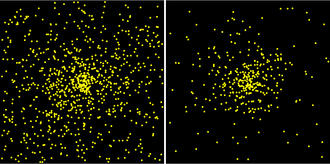
Ewa Łokas and collaborators reproduced the properties of ultra-faint galaxies of the Local Group as a result of tidal interactions with the Milky Way of disky galaxies embedded in dark matter haloes with shallow density profiles.
Over the last decade about a dozen of ultra-faint spheroidal galaxies were discovered by the Sloan Digital Sky Survey. The discoveries allowed us to partially solve the so-called missing satellites problem, the fact that we observe much fewer dwarf galaxies in the Local Group than predicted by the theory based on cold dark matter. It seems that the problem is also related to another puzzle, the discrepancy between the measured and the predicted shapes of dark matter density profiles in the centres of dwarf galaxies. While the theory predicts that the density of dark matter should rise steeply towards the centre of the galaxy, the observations suggest that the distribution is rather flat. Simulations taking into account the processes of stellar evolution solve this problem and explain the change in the density profiles via outflows of matter induced by supernovae.
All galaxies start their life as stellar disks embedded in dark matter haloes. However, the neighbourhood of the Milky Way is dominated by dwarf spheroidal galaxies. We explain their origin as a result of tidal interaction with a big galaxy. It turns out that if the initial small disk galaxy had a dark matter halo with a shallow density profile, its evolution proceeds much faster. Strong mass loss occurring on sufficiently tight orbit often leads to complete disruption of the galaxy, explaining why only a few such object are observed. In some cases a very small object forms at an intermediate stage, with properties remarkably similar to those of the ultra-faint galaxies recently discovered in the vicinity of the Milky Way. The plots show the stellar component in two such objects formed in simulations. In the region of size 1 kpc^3 the galaxies contain only 907 (the object on the left) and 356 (the object on the right) stars. Full article.






